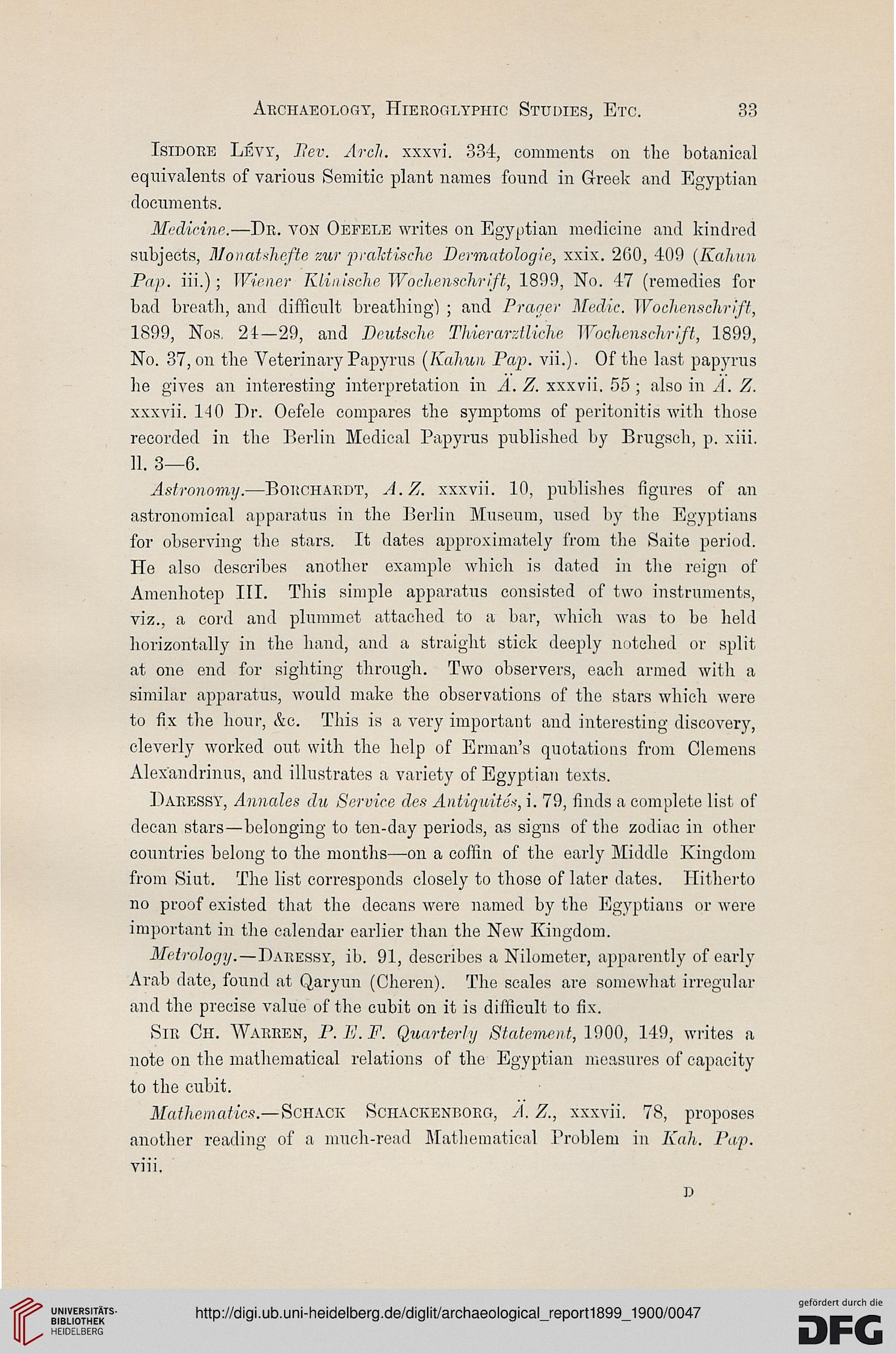Archaeology, Hieroglyphic Studies, Etc.
33
Isidore Levy, T!ev. Arch, xxxvi. 334, comments on the botanical
equivalents of various Semitic plant names found in Greek and Egyptian
documents.
Medicine—Dr. yon Oefele writes on Egyptian medicine and kindred
subjects, Afonatshefte mr prahtische Dermatologie, xxix. 260, 409 (Kahun
Pap. iii.); Wiener Kliaische Wqchensehrift, 1899, No. 47 (remedies for
bad breath, and difficult breathing) ; and Prager Medic. Wochenschrift,
1899, Nos. 21—29, and Deutsche, Thierarztliche Wochenschrift, 1899,
No. 37, on the Veterinary Papyrus [Kahun Pap. vii.). Of the last papyrus
he gives an interesting interpretation in A. Z. xxxvii. 55 ; also in A. Z.
xxxvii. 110 Dr. Oefele compares the symptoms of peritonitis with those
recorded in the Berlin Medical Papyrus published by Brugsch, p. xiii.
11. 3—6.
Astronomy.—Borchardt, A.Z. xxxvii. 10, publishes figures of an
astronomical apparatus in the Berlin Museum, used by the Egyptians
for observing the stars. It dates approximately from the Saite period.
He also describes another example which is dated in the reign of
Amenhotep III. This simple apparatus consisted of two instruments,
viz., a cord and plummet attached to a bar, which was to be held
horizontally in the hand, and a straight stick deeply notched or split
at one end for sighting through. Two observers, each armed with a
similar apparatus, would make the observations of the stars which were
to fix the hour, &c. This is a very important and interesting discovery,
cleverly worked out with the help of Erman's quotations from Clemens
Alexandrinus, and illustrates a variety of Egyptian texts.
Daressy, Annates du Service des Antiquite*, i. 79, finds a complete list of
decan stars—belonging to ten-day periods, as signs of the zodiac in other
countries belong to the months—on a coffin of the early Middle Kingdom
from Siut. The list corresponds closely to those of later dates. Hitherto
no proof existed that the decans were named by the Egyptians or were
important in the calendar earlier than the New Kingdom.
Metrology. — Daressy, ib. 91, describes a Nilometer, apparently of early
Arab date, found at Qaryun (Cheren). The scales are somewhat irregular
and the precise value of the cubit on it is difficult to fix.
Sir Ch. Warren, P. E. F. Quarterly Statement, 1900, 149, writes a
note on the mathematical relations of the Egyptian measures of capacity
to the cubit.
Mathematics.— Schack Schackenborg, A. Z., xxxvii. 78, proposes
another reading of a much-read Mathematical Problem in Kali. Pap.
viii.
d
33
Isidore Levy, T!ev. Arch, xxxvi. 334, comments on the botanical
equivalents of various Semitic plant names found in Greek and Egyptian
documents.
Medicine—Dr. yon Oefele writes on Egyptian medicine and kindred
subjects, Afonatshefte mr prahtische Dermatologie, xxix. 260, 409 (Kahun
Pap. iii.); Wiener Kliaische Wqchensehrift, 1899, No. 47 (remedies for
bad breath, and difficult breathing) ; and Prager Medic. Wochenschrift,
1899, Nos. 21—29, and Deutsche, Thierarztliche Wochenschrift, 1899,
No. 37, on the Veterinary Papyrus [Kahun Pap. vii.). Of the last papyrus
he gives an interesting interpretation in A. Z. xxxvii. 55 ; also in A. Z.
xxxvii. 110 Dr. Oefele compares the symptoms of peritonitis with those
recorded in the Berlin Medical Papyrus published by Brugsch, p. xiii.
11. 3—6.
Astronomy.—Borchardt, A.Z. xxxvii. 10, publishes figures of an
astronomical apparatus in the Berlin Museum, used by the Egyptians
for observing the stars. It dates approximately from the Saite period.
He also describes another example which is dated in the reign of
Amenhotep III. This simple apparatus consisted of two instruments,
viz., a cord and plummet attached to a bar, which was to be held
horizontally in the hand, and a straight stick deeply notched or split
at one end for sighting through. Two observers, each armed with a
similar apparatus, would make the observations of the stars which were
to fix the hour, &c. This is a very important and interesting discovery,
cleverly worked out with the help of Erman's quotations from Clemens
Alexandrinus, and illustrates a variety of Egyptian texts.
Daressy, Annates du Service des Antiquite*, i. 79, finds a complete list of
decan stars—belonging to ten-day periods, as signs of the zodiac in other
countries belong to the months—on a coffin of the early Middle Kingdom
from Siut. The list corresponds closely to those of later dates. Hitherto
no proof existed that the decans were named by the Egyptians or were
important in the calendar earlier than the New Kingdom.
Metrology. — Daressy, ib. 91, describes a Nilometer, apparently of early
Arab date, found at Qaryun (Cheren). The scales are somewhat irregular
and the precise value of the cubit on it is difficult to fix.
Sir Ch. Warren, P. E. F. Quarterly Statement, 1900, 149, writes a
note on the mathematical relations of the Egyptian measures of capacity
to the cubit.
Mathematics.— Schack Schackenborg, A. Z., xxxvii. 78, proposes
another reading of a much-read Mathematical Problem in Kali. Pap.
viii.
d





